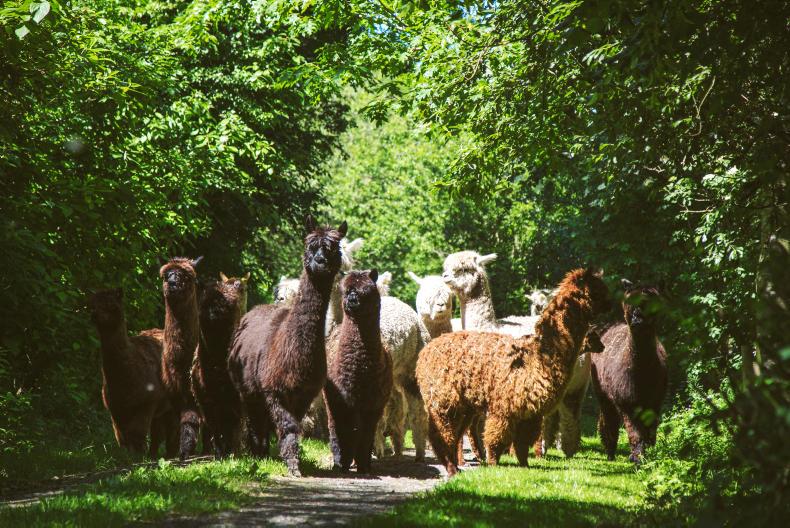At Killinagh Lodge, just outside Carbury in Co Kildare, 30 alpacas owned by Xandria Williams make up what is Alpacas of Ireland. Xandria, on top of part-time alpaca farming, is a London-based naturopath (a practitioner of alternative therapy) and quite literally wrote the book on raising alpacas in Ireland. They are low-maintenance and require very little human intervention, which makes them an attractive option to people with small holdings. This is what attracted Xandria when she started the first large breeding herd in Ireland back in 2001.
“I thought I’d get a couple of alpacas as pets – very dangerous thing, wanting alpacas as pets … I ended up with 130 of them,” Xandria laughs, though in recent years she has reduced the size of her flock back to 30.
Listen to Barry Cassidy on his visit to the alpaca farm in our podcast below:
Having inherited 15 acres of overgrown and boggy land from her aunt, Xandria, who had been living and working in London, eventually settled on alpacas as the way to utilise the otherwise idle ground. She became a weekend commuter to Ireland to look after her animals.
“The thing was, farmers I went to in England to look at [alpacas] had been looking for quite some time for someone to breed them over here. I did say no initially, but obviously not very strongly,” she explains.
But what exactly are alpacas and what are they used for? Well, imagine what can only be described as a cross between a sheep and a small giraffe. Not to be confused with llamas, their larger cousin, alpacas are coveted for the fibre they produce. This fibre is softer than even cashmere, Xandria says, and can be used to make a variety of knitted, felted or woven products.
South American heritage
Traditionally used to make ponchos in South America, alpaca yarn can also be used in other clothing items, in addition to blankets. Unlike sheep wool, alpaca fibres are referred to as hairs and are three times as strong, while still being remarkably soft.
Alpaca fibre usually sells for around €14 per kilo, according to Teagasc, but this will largely depend on the colour, quality and amount sold. Sheep wool, by comparison, is currently selling for €0.60/kg. Xandria sells her fleeces to a combination of cottage industries and individual spinners or weavers as, well as exporting some to the UK.
Irish Country Living went along to the annual shearing of Xandria’s alpacas to witness first-hand the harvesting of this unique product. Xandria is extremely open and regularly invites people to her farm to see what it’s like to own alpacas and hopefully encourage them to set up herds of their own.
Shearing
So, how exactly do you shear an alpaca? Well, first you need a qualified shearer in order to avoid any damage to the alpaca’s soft skin and ensure all the precious wool is correctly removed. For Xandria, this means enlisting the help of Geoff Coller. He is a former sheep shearing record holder who has now retired from regular sheep shearing work.
Geoff is originally from Australia, but has lived in Ireland for over 20 years now.
“I remember seeing an alpaca being shorn somewhere and I thought: ‘I’ve got to have a go at that.’ I went to England to do a course on alpaca shearing and here I am now,” he says.
The first part of the process is to place the alpaca in a harness. This is as much for the animal’s own safety as for the shearer’s. The belly wool, which is too coarse to be used, is removed. Next the saddle is removed: this is the most valuable part of the fleece and usually weighs between 2.5kg and 5kg. After that, what is referred to as the second quality fleece is removed. This comes from the upper legs and neck and can be used in coats and other lined garments. Finally the “thirds”, taken from the outer edges of the alpaca, are used to stuff pillows and cushions.
The whole process takes about five minutes. The alpaca then has its hooves and teeth checked and trimmed, if necessary, before returning to the field unrecognisable from the animal that entered the pen prior to shearing. Missing four inches of fleece from either side of its body, as well as neck and legs that look too long for its body, it is a transition that needs to be seen to be believed.
In addition to their fleece, the alpaca also has other uses. They are commonly used as guard animals. While usually endearing and docile, alpacas are aggressive only to foxes and wild dogs, and are instinctively predisposed to chase them away. This makes them ideal to run with a sheep flock or to protect hens or other poultry from predators. CL
For anyone interested in owning an alpaca or who just wants to find out more about these incredible animals, check out www.alpacasofireland.com or email Xandria at xandria@xandriawilliams.co.uk.
